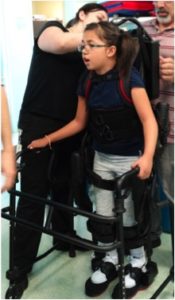EKSO Bionics Exoskeleton at TK
Blending Love and Compassion with Technology
The underlying current that guides everything we do at Totally Kids Rehabilitation Hospital is the love and compassion we have for our patients and our commitment to offering them the very best possible care we can offer. That love and commitment propels us to continuously explore ways to broaden our family of therapies, so that our patients can receive the most beneficial, up-to-date, and effective treatment and care possible.
With this in mind, we recently added the EKSO Bionics Exoskeleton to our family of therapies. The exoskeleton gives patients with lower-extremity paralysis or weakness, such as those associated with stroke or injuries to the brain or the spinal cord, the opportunity to stand and walk with minimal assistance. Walking occurs in a coordinated manner that helps the body re-learn proper step pattern and weight shifts.
The exoskeleton provides therapists with continuous and immediate feedback, allowing them to determine the difference between the amount of work being performed by the machine and the child.
What Does It Look Like and How Does It Work?
By definition, the exoskeleton is basically a skeleton worn on the outside of the body. It is sturdy enough to give a person physical support, but light enough to be able to be handled by our patients. It looks very much like a futuristic backpack connected to a waist belt. The belt is attached to what can be described as adjustable leg braces that line each side of each leg and link to a pair of boots at the bottom.
The exoskeleton is a wearable suit that is adjusted to the size of each patient. From the seated position, the backpack, waist belt, knee straps, and boots are adjusted on the patient. A therapist stands behind the patient, with a control in hand that tells the exoskeleton to stand at the appropriate time. Another therapist stands in front of the patient, as it is required for pediatric facilities.
Once standing, the patient begins to send signals to the exoskeleton through leg muscle movements or by slightly shifting the hips from side to side. Once the signals are received, the exoskeleton begins to walk. If it detects that a patient is not coordinated, the exoskeleton stops and holds the patient in place until he or she is ready to begin the process again.
Effects on Neuroplasticity
The exoskeleton is particularly beneficial to patients who have suffered any loss in the connectivity between a muscle and the brain. In those cases, patients will experience a decrease, or an altogether inability to move the muscle. If the muscle affected is used in the process of walking, then that patient’s ability to walk will be impaired partially, or altogether.
Use of the exoskeleton can result in a “rewiring” of those neurological pathways so that a muscle and the brain can regain connectivity. The effects of this rewiring are varied. For example, some patients may experience an improved ambulating gait pattern, or an improvement in the quality of their ability to walk. Others may find that as the brain signals reach an affected muscle, that muscle regains strength and some mobility, thus avoiding becoming atrophied.
Different Settings for Different Patients
Members of our staff trained to work with the exoskeleton are able to interact with it to specify the goals for each patient during every session. For example, our therapists may adjust the exoskeleton so that it provides different amounts of power to the left and the right leg, depending on the therapy needs of a patient. The exoskeleton allows therapists begin mobility earlier in some patients, while our physicians are able to analyze data and improvements gained during each therapy session.
We are happy to welcome this incredibly effective tool into our family of therapies, and we are strong in our commitment to providing our kids with the best possible level of care.

You must be logged in to post a comment.